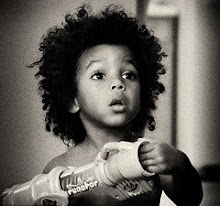Hoop Dreams and the Reinforcement of Cultural Stereotypes Through Film
In the chapter on Hoop Dreams from her book, Reel to Real, Bell Hooks argues that, far from being a great documentary worthy of the praise lauded upon it, Hoops Dreams was essentially a propaganda piece designed to reinforce popular stereotypes of inner city blacks. The movie had the classic ghetto characters one would expect to find in the average "ethnic" film--the single mother struggling to keep the family together, the drug-addicted father who isn't there, and most importantly, basketball players.
Hooks makes much of the fact that the film does little to challenge the prevailing perception that one of the only ways a black male can rise in society is by being an athlete. She compares the commodification of these black boys by coaches and talent scounts to that of the slave market economy, where the worth of a black man is determined by his physical prowess. Once the body breaks down, they are of no more use and are cut loose in a skewed "what have you done for my lately?" mentality. When William Gates blows out his knee a second time and walks away from the game, he is portrayed as the "loser" in the invented competition between the two boys. In reality there was no "competition" between Gates and Arthur Agee, but the film is constructed in such a way as to create tension and drama between the two.
I don't remember what Gates ended up doing--it's been a long time since I've seen the film. But I do remeber Agee going to some crappy college in the middle of nowhere so that he could continue playing basketball and chasing the dream. He did get to continue his education becuase of basketball, but that is simply a sidebar, not why he's the "winner." Society doesn't care about the education of young black men. Playing basketball isn't portrayed as a vehicle towards an education, it's the end in and of itself.
Negative stereotypical images of blacks, espeically black men, pervade our society and the media does little to challenge these assumptions. Blacks can be atheletes, singers, dancers, in short--entertainers. Or criminals. Hell, even the atheletes and singers are criminals these days. Gradually, people begin to take on the persona that the media assigns for them, begin to believe what they are told about themselves--a classic example of life imitating art. There are very few positive portrayls of blacks in the mainstream media. Even now, during Black History Month (the shortest, coldest month of the year--thanks, white America!) the images are repetative--Martin Luther King, Harriet Tubman, George Washington Carver, Fredrick Douglass. Others may get a little face time, but every February, without fail come the big 4--the Mount Rushmore of black history. Few people have heard of Carter G. Woodson, Bejnamin Banneker, Garrett Morgan, or Charles Drew. On the History Channel website, they have a list of "African American icons" up for Black History Month. 34 out of 65 are atheletes, musicians or actors. What message is this sending to the black youth of America? During his speech at the 2004 Democratic National Convention, Barak Obama said that we must "eradicate the slander that says a black youth with a book is acting white." Unless the media changes the way blacks are portrayed, I fear that that slander with be with us for many years to come. Sorry Barak.

